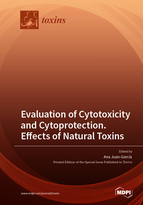Evaluation of Cytotoxicity and Cytoprotection. Effects of Natural Toxins
A special issue of Toxins (ISSN 2072-6651). This special issue belongs to the section "Mycotoxins".
Deadline for manuscript submissions: closed (30 November 2021) | Viewed by 22605
Special Issue Editor
Interests: toxicological effects of food contaminants, specifically mycotoxins; risk assessment of food contaminants with a focus on human’s health; factors that influence intestinal bioavailability and investigation of methods to decrease mycotoxins’ effects; new advanced techniques in elucidating mycotoxins’ toxicological effects implementing the 3R’s principle
Special Issues, Collections and Topics in MDPI journals
Special Issue Information
Dear Colleagues,
The lifestyle associated with good quality of food is well known for its widely recognized health benefits, especially when rich in bioactive compounds. Reduced risks of some types of cancer and other diseases have been associated with the adoption of such a diet, as have increased antioxidants, inhibitors of lipid peroxidation, decrease of pro-inflammatory cytokine production, etc. Their classification is very wide, including lycopenes, carotenoids, and polyphenols (flavonoids and non-flavonoids). Nevertheless, the presence of natural toxins in food usually happens due to a lack in harvesting, storage or packaging, or climate changes and atmospheric conditions. Such toxins can have different origins, as from plants, fungi, algae, bacteria, marine biotoxins including mycotoxins, lectins, furocoumarins, shiga toxin, ciguatoxins, etc. Studies at the cellular level attributed to natural toxins precede those toxins detected in organs and systems. Evaluation of the effects of natural toxins and biologically active compounds of extracts from the plant kingdom constitute a potential to combat various diseases thanks to its rich content. The focus of this Special Issue of Toxins is to gather the most recent advances related to the cytotoxicity of natural toxins and the potential for the cytoprotection of natural compounds present in food, thus, papers dealing with cellular systems are welcome. In this context, omics data are also encouraged. Both research papers and review articles proposing novelties or overviews, respectively, are welcome.
Prof. Dr. Ana Juan-García
Guest Editor
Manuscript Submission Information
Manuscripts should be submitted online at www.mdpi.com by registering and logging in to this website. Once you are registered, click here to go to the submission form. Manuscripts can be submitted until the deadline. All submissions that pass pre-check are peer-reviewed. Accepted papers will be published continuously in the journal (as soon as accepted) and will be listed together on the special issue website. Research articles, review articles as well as short communications are invited. For planned papers, a title and short abstract (about 100 words) can be sent to the Editorial Office for announcement on this website.
Submitted manuscripts should not have been published previously, nor be under consideration for publication elsewhere (except conference proceedings papers). All manuscripts are thoroughly refereed through a double-blind peer-review process. A guide for authors and other relevant information for submission of manuscripts is available on the Instructions for Authors page. Toxins is an international peer-reviewed open access monthly journal published by MDPI.
Please visit the Instructions for Authors page before submitting a manuscript. The Article Processing Charge (APC) for publication in this open access journal is 2700 CHF (Swiss Francs). Submitted papers should be well formatted and use good English. Authors may use MDPI's English editing service prior to publication or during author revisions.
Keywords
- mycotoxins
- cells
- in vitro
- alternative methods
- cytometry
- mass cytometry
- metabolomics
- cytotoxicity
- cytoprotection
- biological systems







